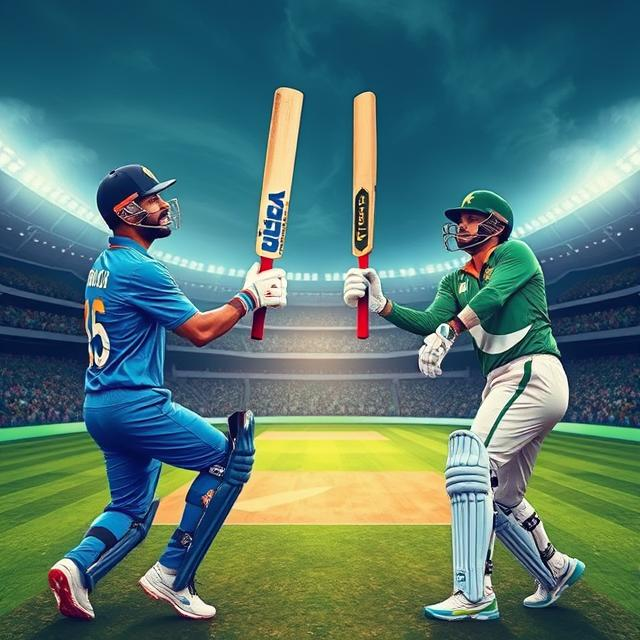India Pakistan Cricket Match Rivalry: A History of Intense Competition
India Pakistan Cricket Match Rivalry: A History of Intense Competition
Beyond the flashing lights of the stadium and the thunderous roar of the crowds, lies a compelling narrative: the enduring rivalry between India and Pakistan in cricket. This isn’t just a sporting contest; it’s a cultural phenomenon, a reflection of shared history, and a battle for national pride that transcends the boundaries of the game itself. This article delves into the rich history of this iconic rivalry, exploring the key moments, the controversies, and the enduring passion that fuels the contests.

A Legacy Forged in Fire: Early Encounters
The rivalry’s genesis can be traced back to the very beginnings of organized cricket in the subcontinent. As British colonies, both nations played cricket, but the emergence of independent India and Pakistan in 1947 marked a watershed moment. The first matches between these newly formed nations were not merely sporting events; they were laden with the weight of political tension, the anxieties of partition, and the hopes for a future yet to be written.
The initial encounters were steeped in a palpable sense of uncertainty. Emotions ran high as each team fought for national identity and self-respect on the field. Players were not just representatives of their teams; they carried the hopes and fears of an entire nation.
The Rise of Intense Competition: The Years of Dominance
As the years progressed, the rivalry intensified. Matches became more than just athletic contests; they became a mirror reflecting the complex relationship between the two countries. Each victory, no matter how small, was fiercely celebrated, while any loss was often met with deep disappointment and a wave of nationalistic fervor.
The period witnessed legendary players from both sides. From the elegant strokes of the early masters to the powerful hitting of modern-day stars, the rivalry produced some of the most memorable performances in cricket history. The sheer athleticism and tactical brilliance displayed by both teams, and indeed individual players, made these contests unforgettable.
Moments That Defined the Rivalry
The history is punctuated by remarkable moments that etched themselves into the collective memory of cricket fans. The close finishes, the dramatic comebacks, the controversial decisions – these have all contributed to the enduring appeal of this rivalry.
Take, for instance, the 1992 World Cup, a tournament that saw both sides pushing their limits. The matches were intense, gripping, and at times even controversial. These encounters weren’t simply about winning; they were about proving national strength and resilience.
More recent matches have also been defining moments. Think of the crucial matches in major tournaments. These have often left a lasting impression, serving as powerful symbols of the competitive spirit that often defines this rivalry.
Beyond the Field: Cultural and Political Undercurrents
The rivalry extends far beyond the sporting arena. It is deeply rooted in the cultural and political landscapes of both countries. The tension between the two nations often spills onto the field of play, adding another layer of complexity to the already intense competition. The emotional outpouring that follows matches often highlights the deep-seated sentiments associated with the rivalry.
The legacy of the rivalry can be seen in the way that cricket is viewed in both nations. It is far more than a pastime; it’s a powerful cultural expression, deeply intertwined with national identity and pride.
The Role of Media and Public Perception
Media coverage plays a crucial role in shaping the public’s perception of the rivalry. The way matches are reported and analysed, the way players and teams are portrayed, can heavily influence public opinion and the emotional response to the matches.
It is impossible to deny the effect of the media on the narrative of the rivalry. Media portrayals, while often meant to add excitement, can sometimes also inadvertently exaggerate the tension, creating an environment of heightened expectations and pressure.
Looking Ahead: The Future of the Rivalry
The India-Pakistan cricket rivalry is not going anywhere. It is a vibrant tapestry woven from the threads of passion, history, and intense competition. As the game evolves, and new generations of players rise to the forefront, the rivalry will continue to shape the landscape of international cricket. This is a competition which transcends just sports and has deeply impacted the national narrative.
While the political climate may continue to influence the narrative, the inherent excitement and drama of the contest between these two teams guarantees that it will remain a defining feature of cricket for years to come. The sheer intensity of the match-ups will continue to captivate audiences, and the rivalry will undoubtedly continue to influence the trajectory of cricket.
Conclusion: A Timeless Legacy
The India-Pakistan cricket match rivalry is a testament to the power of sport to unite and divide, to celebrate and mourn. It is a compelling story of national pride, fierce competition, and the enduring human desire for victory. It reminds us that sports, at their heart, are often a reflection of the larger socio-political landscape in which they exist. It is a rivalry that will continue to inspire passionate debate and analysis for generations to come.